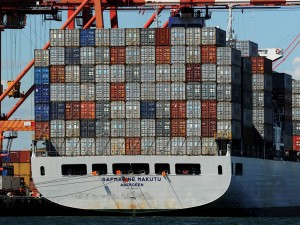PH exporters work overtime to improve trade

The country’s exporters need to ramp up revenue generation if they hope to double their dollar receipts by 2016, from that of 2010 when President Aquino assumed office, the Export Development Council says.
MANILA, Philippines—The country’s exporters need to ramp up revenue generation if they hope to double their dollar receipts by 2016, from that of 2010 when President Aquino assumed office, according to the Export Development Council (EDC).
The EDC, composed of representatives from the government and private sector, resolved to increase merchandise exports by an average of 15 percent in order to attain its $61-billion target for 2013, $70.26 billion for 2014, $80.8 billion for 2015, and $92.92 billion for 2016.
The $92.92 billion would be the merchandise component of the overall exports target of $120 billion by 2016. The rest should come from the services sector led by the BPO industry.
Merchandise exports reached an all-time high of $51.4 billion in 2010 and was supposed to grow by 10 percent every year until 2013.
But shipments dipped to about $48 billion in 2011 due to a faltering world economy. For 2012, exports appeared to have recovered, posting an estimated $53 billion in receipts.
Final estimates on exports revenue for 2012 will be announced in February, according to outgoing Trade Undersecretary Cristino L. Panlilio.
Once the 2012 data have been finalized, “we will … see if there is a need to revise targets,” EDC private sector chairman Sergio R. Ortiz Luis Jr. said in a phone interview.
“We have to achieve a higher growth rate every year to meet [the 2016] target,” said Ortiz Luis, who is also president of the Philippine Exporters Confederation, Inc.
The EDC has four key strategies to meet targets.
On product development, it will support value-added products and premium items, such as organic and natural products.
On marketing, EDC will train exporters to make the most of free trade agreements, promote exports in high-growth markets, and attract manufacturer-exporters looking for new hubs outside Japan, China and Thailand.
On promotions, EDC will focus on fewer but bigger trade fairs and organize inbound fairs and missions together with the tourism industry.
On governance, the EDC will support 10 pending pieces of legislation that cover export development and the fight against smuggling, among others.
Meanwhile, a World Bank report said that the share of the Philippines and other developing countries in global trade will continue to expand in the next three years, despite weaker world output, because trade with other developing nations is expected to grow.
In its recently released Global Economic Prospects report, the World Bank said developing country imports would expand by an annual average rate of 8 percent from 2013 to 2015, compared with the 5.9 percent expected of high-income countries.
The World Bank identified persistent economic difficulties in the eurozone, the fiscal problems of the United States, and a sharp decline in China’s growth to be among the risks that could derail trade in the years to come.
The bank expected the Philippine economy to expand by 6.2 percent this year.
